A Thermo-Hydro-Mechanical-Chemical Coupling Model and Its Application in Acid Fracturing Enhanced Coalbed Methane Recovery Simulation
Abstract
:1. Introduction
2. Mechanism of AF-ECBM and THMC Coupling Responses
2.1. Permeability Enhancement by Acid Fracturing
2.2. THMC Coupling Responses
- For the mechanical field, the stress mainly determine the initiation and development of fractures in coal and rock, thus affecting their porosity and permeability, as well as the fluid (gas and water) seepage in coal seams. The improvement of the fracture network induced by mechanical stress provides more sites for chemical reactions. The change of strain energy is one of the forms for thermal transfer.
- For the hydraulic field, the fluid migration controls the process of mass (gas, acid) transport and heat transfer. The reservoir pressure and two phase flow during AF-ECBM will affect the physical properties and effective stress of the coal seam, as well as the mechanical field. The seepage rate of fluid will affect the speed and spatial scope of chemical reactions between acid and minerals. The heat transfer by means of heat conduction and convection within a coal seam is promoted by hydraulic migration.
- For the chemical field, the chemical reaction will consume minerals or blockages in coal seam, and increase the porosity and permeability. The strength of the corroded coal is reduced, and the stress field in coal seam is redistributed. Meanwhile, the chemical reaction process is accompanied by the consumption or generation of heat, and thus the temperature distribution is affected.
- For the thermal field, the density and viscosity of fluids vary with the change of temperature in the coal seam, which significantly influences the fluid flow characteristics. The higher the temperature, the greater the activation energy and the more intense the molecular activity is. This promotes the desorption of adsorbed gas from the coal matrix and increases the rate of chemical reactions. Due to the change of temperature, the coal skeleton will also be deformed, which generates thermal stress and further affects the distribution of the stress field in the coal.
3. THMC Coupling Model for AF-ECBM Recovery Simulation
3.1. Basic Hypothesis
3.2. Governing Equations of THMC Model
3.2.1. Governing Equations of Mechanical Field
3.2.2. Governing Equation of Hydraulic Field
3.2.3. Governing Equation of Chemical Field
3.2.4. Governing Equation of Temperature Field
3.2.5. Porosity and Permeability
3.2.6. Solving Process of the THMC Coupled Model
4. Numerical Simulation of Acid Fracturing Enhanced CBM Recovery
4.1. Physical Model Setting
4.2. Simulation Schemes
4.3. Results and Discussion
4.3.1. Distribution of Damage Variable
4.3.2. Distribution of Elastic Modulus
4.3.3. Distribution of Reservoir Permeability
4.3.4. Evolution of Gas Pressure
4.3.5. Variation of Gas Production
5. Conclusions
Author Contributions
Funding
Acknowledgments
Conflicts of Interest
References
- Beamish, B.B.; Crosdale, P.J. Instantaneous outbursts in underground coal mines: An overview and association with coal type. Int. J. Coal Geol. 1998, 35, 27–55. [Google Scholar] [CrossRef]
- Fan, C.; Li, S.; Luo, M.; Du, W.; Yang, Z. Coal and gas outburst dynamic system. Int. J. Min. Sci. Technol. 2017, 27, 49–55. [Google Scholar] [CrossRef]
- Wang, G.; Li, W.; Wang, P.; Yang, X.; Zhang, S. Deformation and gas flow characteristics of coal-like materials under triaxial stress conditions. Int. J. Rock Mech. Min. Sci. 2017, 91, 72–80. [Google Scholar] [CrossRef]
- Liu, T.; Lin, B.; Yang, W.; Zhai, C.; Liu, T. Coal permeability evolution and gas migration under non-equilibrium state. Transp. Porous Media 2017, 118, 393–416. [Google Scholar] [CrossRef]
- Lv, Y.M.; Tang, D.Z.; Xu, H.; Luo, H.H. Production characteristics and the key factors in high-rank coalbed methane fields: A case study on the Fanzhuang Block, Southern Qinshui Basin, China. Int. J. Coal Geol. 2012, 96–97, 93–108. [Google Scholar] [CrossRef]
- Yang, Y.; Zhang, C.W.; Tian, H.J.; Chen, W.G.; Peng, X.D.; Zhang, H. The pilot appraisal of acid fracturing of coalbed methane reservoir in southeast Qinshui Basin, China. Earth Sci. Res. J. 2016, 20, C1–C6. [Google Scholar] [CrossRef]
- Wang, G.; Wang, K.; Wang, S.; Elsworth, D.; Jiang, Y. An improved permeability evolution model and its application in fractured sorbing media. J. Nat. Gas. Sci. Eng. 2018, 56, 222–232. [Google Scholar] [CrossRef]
- Fan, C.; Li, S.; Luo, M.; Yang, Z.; Lan, T. Numerical simulation of hydraulic fracturing in coal seam for enhancing underground gas drainage. Energ. Explor. Exploit. 2019, 37, 166–193. [Google Scholar] [CrossRef]
- Gao, J.F.; Xing, H.L.; Turner, L.; Steel, K.; Sedek, M.; Golding, S.D.; Rudolph, V. Pore-Scale Numerical Investigation on chemical stimulation in coal and permeability enhancement for coal seam gas production. Transp. Porous Media 2017, 116, 335–351. [Google Scholar] [CrossRef]
- Wang, G.; Chu, X.; Yang, X. Numerical simulation of gas flow in artificial fracture coal by three-dimensional reconstruction based on computed tomography. J. Nat. Gas Sci. Eng. 2016, 34, 823–831. [Google Scholar] [CrossRef]
- Ji, L.; Settari, A.; Sullivan, R.B. A novel hydraulic fracturing model fully coupled with geomechanics and reservoir simulation. SPE J. 2009, 14, 423–430. [Google Scholar] [CrossRef]
- Huang, B.X.; Huang, C.M.; Cheng, Q.Y. Hydraulic fracturing technology for improving permeability in gas-bearing coal seams in underground coal mines. J. S. Afr. I. Min. Metall. 2012, 112, 485–495. [Google Scholar]
- Adachi, J.; Siebrits, E.; Peirce, A.; Desroches, J. Computer simulation of hydraulic fractures. Int. J. Rock Mech. Min. Sci. 2007, 44, 739–757. [Google Scholar] [CrossRef]
- Song, Y.; Jiang, B.; Lan, F.J. Competitive adsorption of CO2/N2/CH4 onto coal vitrinite macromolecular: Effects of electrostatic interactions and oxygen functionalities. Fuel 2019, 235, 23–38. [Google Scholar]
- Wong, S.; Law, D.; Deng, X.; Robinson, J.; Kadatz, B.; Gunter, W.D.; Fan, Z. Enhanced coalbed methane and CO2 storage in anthracitic coals—micro-pilot test at South Qinshui, Shanxi, China. Int. J. Greenh. Gas Control 2007, 1, 215–222. [Google Scholar] [CrossRef]
- Kumar, H.; Elsworth, D.; Mathews, J.P.; Liu, J.; Pone, D. Effect of CO2 injection on heterogeneously permeable coalbed reservoirs. Fuel 2014, 135, 509–521. [Google Scholar] [CrossRef]
- Wu, Y.; Liu, J.S.; Elsworth, D.; Chen, Z.W.; Connell, L.; Pan, Z.J. Dual poroelastic response of a coal seam to CO2 injection. Int. J. Greenh. Gas Control 2010, 4, 668–678. [Google Scholar] [CrossRef]
- Durucan, S.; Shi, J.Q. Improving the CO2 well injectivity and enhanced coalbed methane production performance in coal seams. Int. J. Coal Geol. 2009, 77, 214–221. [Google Scholar] [CrossRef]
- Yan, F.Z.; Lin, B.Q.; Zhu, C.J.; Shen, C.M.; Zou, Q.L.; Guo, C.; Liu, T. A novel ECBM extraction technology based on the integration of hydraulic slotting and hydraulic fracturing. J. Nat. Gas Sci. Eng. 2015, 22, 571–579. [Google Scholar] [CrossRef]
- Lu, C.P.; Dou, L.M.; Zhang, N.; Xue, J.H.; Liu, G.J. Microseismic and acoustic emission effect on gas outburst hazard triggered by shock wave: A case study. Nat. Hazards 2014, 73, 1715–1731. [Google Scholar] [CrossRef]
- Vassilev, S.V.; Kitano, K.; Takeda, S.; Tsurue, T. Influence of mineral and chemical-composition of coal ashes on their fusibility. Fuel Process. Technol. 1995, 45, 27–51. [Google Scholar] [CrossRef]
- Balucan, R.D.; Turner, L.G.; Steel, K.M. Acid-induced mineral alteration and its influence on the permeability and compressibility of coal. J. Nat. Gas Sci. Eng. 2016, 33, 973–987. [Google Scholar] [CrossRef]
- Laubach, S.E.; Marrett, R.A.; Olson, J.E.; Scott, A.R. Characteristics and origins of coal cleat: A review. Int. J. Coal Geol. 1998, 35, 175–207. [Google Scholar] [CrossRef]
- Ward, C.R. Analysis and significance of mineral matter in coal seams. Int. J. Coal Geol. 2002, 50, 135–168. [Google Scholar] [CrossRef]
- Zhao, B.; Wen, G.; Sun, H.; Zhao, X. Experimental Study of the pore structure and permeability of coal by acidizing. Energies 2018, 11, 1162. [Google Scholar] [CrossRef]
- Zhu, W.C.; Wei, C.H.; Li, S.; Wei, J.; Zhang, M.S. Numerical modeling on destress blasting in coal seam for enhancing gas drainage. Int. J. Rock Mech. Min. Sci. 2013, 59, 179–190. [Google Scholar] [CrossRef]
- Xia, T.; Zhou, F.; Liu, J.; Kang, J.; Gao, F. A fully coupled hydro-thermo-mechanical model for the spontaneous combustion of underground coal seams. Fuel 2014, 125, 106–115. [Google Scholar] [CrossRef]
- Harpalani, S.; Schraufnagel, R.A. Shrinkage of coal matrix with release of gas and its impact on permeability of coal. Fuel 1990, 69, 551–556. [Google Scholar] [CrossRef]
- Xu, T.; Tang, C.A.; Yang, T.H.; Zhu, W.C.; Liu, J. Numerical investigation of coal and gas outbursts in underground collieries. Int. J. Rock Mech. Min. Sci. 2006, 43, 905–919. [Google Scholar] [CrossRef]
- Li, S.; Fan, C.; Han, J.; Luo, M.; Yang, Z.; Bi, H. A fully coupled thermal-hydraulic-mechanical model with two-phase flow for coalbed methane extraction. J. Nat. Gas Sci. Eng. 2016, 33, 324–336. [Google Scholar] [CrossRef]
- Rutqvist, J.; Wu, Y.S.; Tsang, C.F.; Bodvarsson, G. A modeling approach for analysis of coupled multiphase fluid flow, heat transfer, and deformation in fractured porous rock. Int. J. Rock Mech. Min. Sci. 2002, 39, 429–442. [Google Scholar] [CrossRef]
- Fan, Y.; Deng, C.; Zhang, X.; Li, F.; Wang, X.; Qiao, L. Numerical study of CO2-enhanced coalbed methane recovery. Int. J. Greenh. Gas Control 2018, 76, 12–23. [Google Scholar] [CrossRef]
- Wu, Y.; Liu, J.; Chen, Z.; Elsworth, D.; Pone, D. A dual poroelastic model for CO2-enhanced coalbed methane recovery. Int. J. Coal Geol. 2011, 86, 177–189. [Google Scholar] [CrossRef]
- Corey, A.T. The interrelation between gas and oil relative permeability. Prod. Mon. 1954, 31, 533–546. [Google Scholar]
- Ma, T.; Rutqvist, J.; Oldenburg, C.M.; Liu, W.; Chen, J. Fully coupled two-phase flow and poromechanics modeling of coalbed methane recovery: Impact of geomechanics on production rate. J. Nat. Gas Sci. Eng. 2017, 45, 474–486. [Google Scholar] [CrossRef] [Green Version]
- Lin, J.; Ren, T.; Wang, G.; Nemcik, J. Simulation investigation of N2-injection enhanced gas drainage: Model development and identification of critical parameters. J. Nat. Gas Sci. Eng. 2018, 55, 30–41. [Google Scholar] [CrossRef]
- Li, Q. The study for kinetics behavior of high viscosity acid-rock reaction. Ph.D Thesis, Chengdu University of Technology, Chengdu, China, 2013. (In Chinese). [Google Scholar]
- Turner, L.G.; Steel, K.M. A study into the effect of cleat demineralisation by hydrochloric acid on the permeability of coal. J. Nat. Gas Sci. Eng. 2016, 36, 931–942. [Google Scholar] [CrossRef] [Green Version]
- Xu, Y. Chemical Reaction Kinetics; Chemical Industry Press: Beijing, China, 2004. (In Chinese) [Google Scholar]
- Zhu, W.C.; Wei, C.H.; Liu, J.; Qu, H.Y.; Elsworth, D. A model of coal-gas interaction under variable temperatures. Int. J. Coal Geol. 2011, 86, 213–221. [Google Scholar] [CrossRef]
- Xue, Y.; Dang, F.; Liu, F.; Li, R.; Ranjith, P.G.; Wang, S.; Cao, Z.Z.; Yang, Y. An elastoplastic model for gas flow characteristics around drainage borehole considering post-peak failure and elastic compaction. Environ. Earth Sci. 2018, 77, 669. [Google Scholar] [CrossRef]
- Fan, K.; Li, Y.; Elsworth, D.; Dong, M.; Yin, C.; Li, Y.; Chen, Z. Three stages of methane adsorption capacity affected by moisture content. Fuel 2018, 231, 352–360. [Google Scholar] [CrossRef]
- Ni, X.M.; Li, Q.Z.; Wang, Y.B.; Gao, S.S. Experimental study on chemical permeability improvement of different rank coal reservoirs using multi-component acid. J. China Coal Soc. 2014, 39, 433–440. (In Chinese) [Google Scholar]


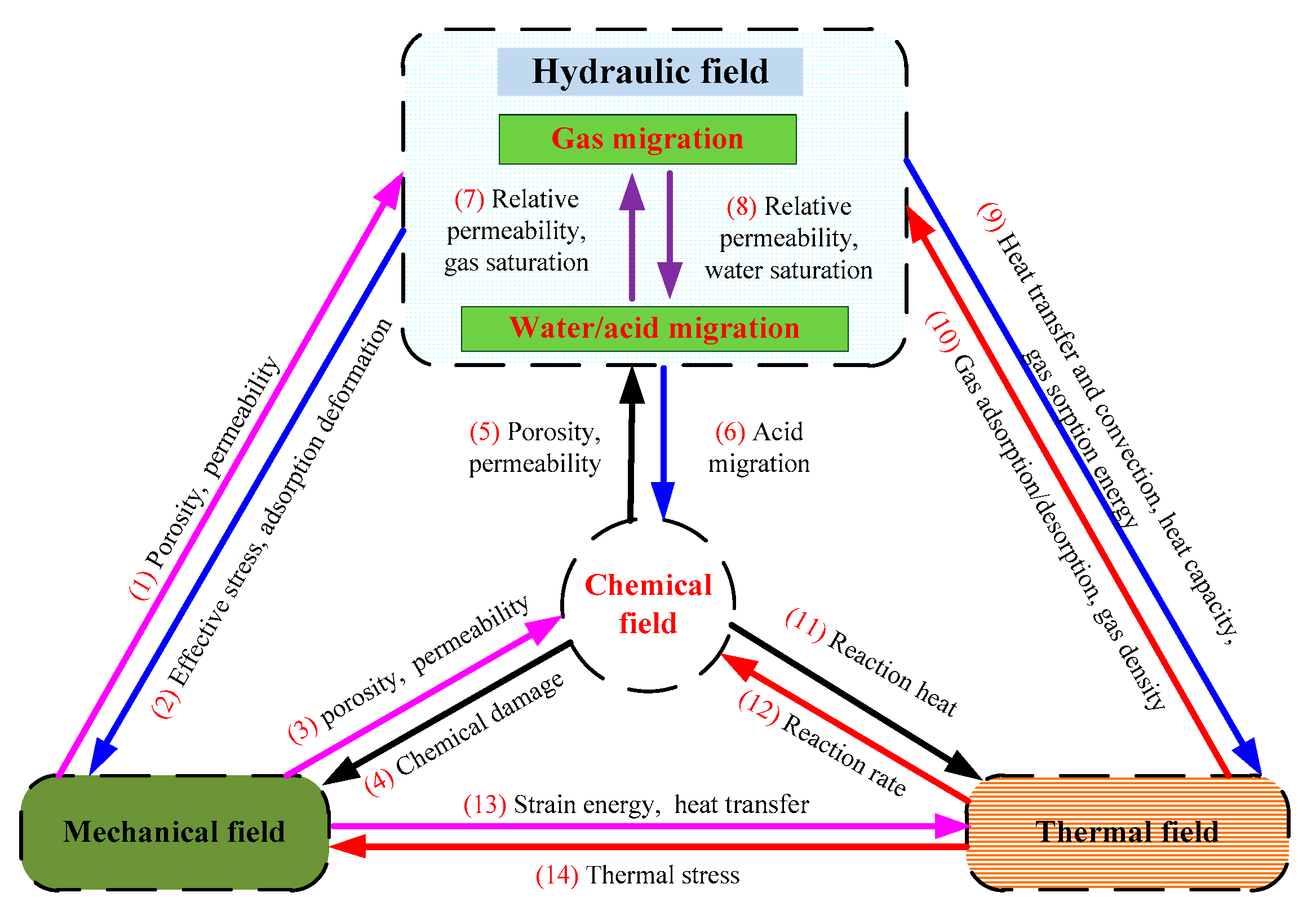
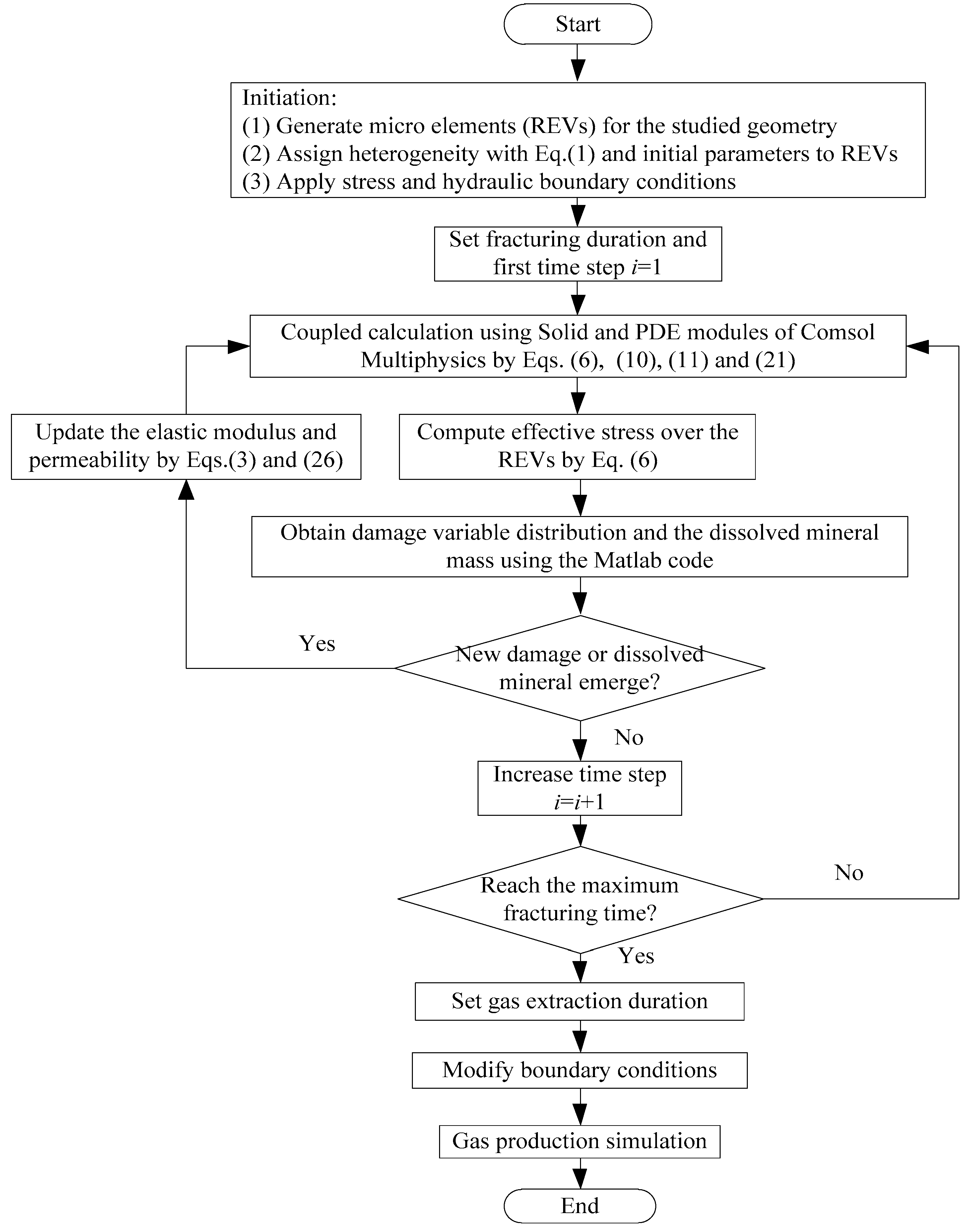
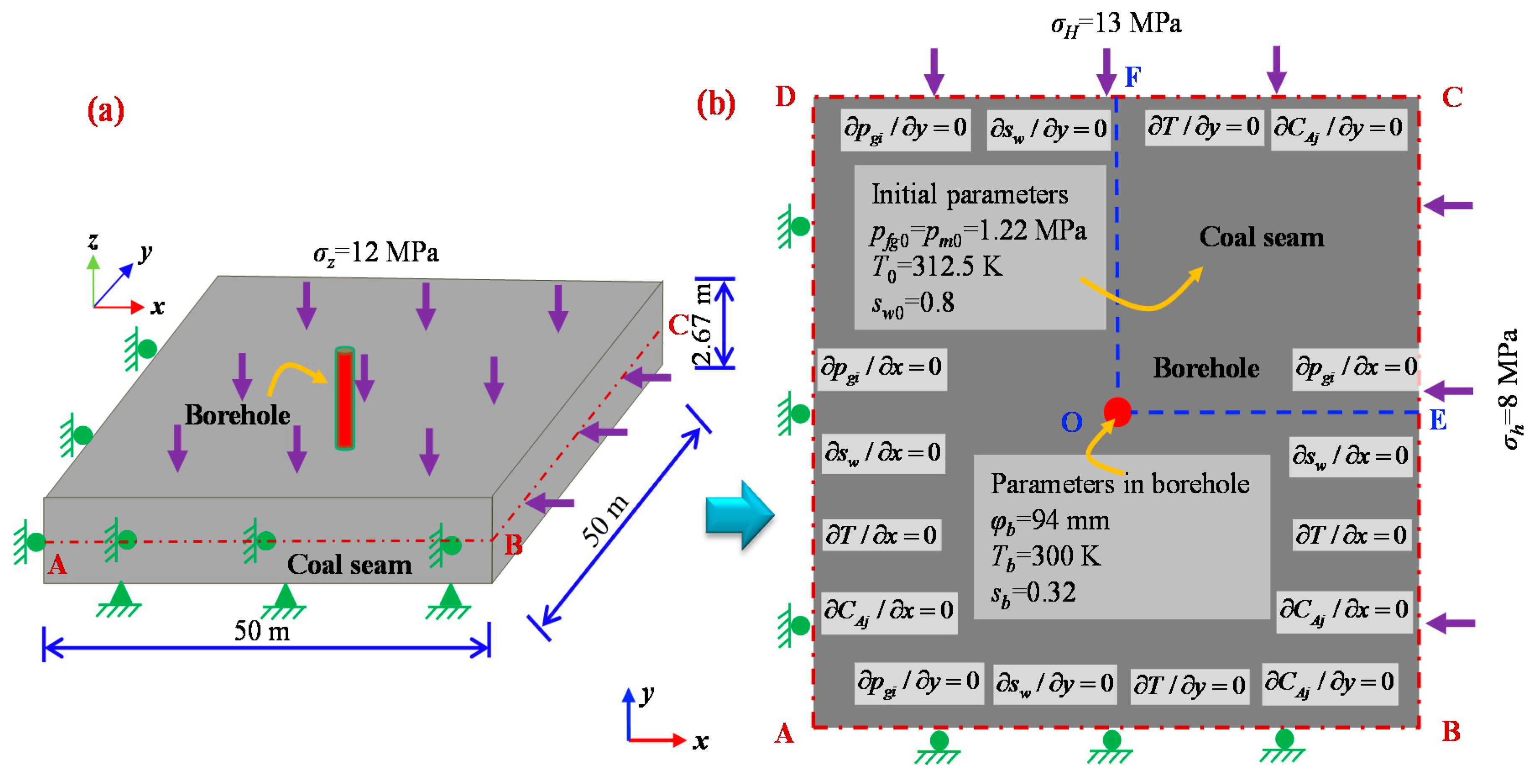
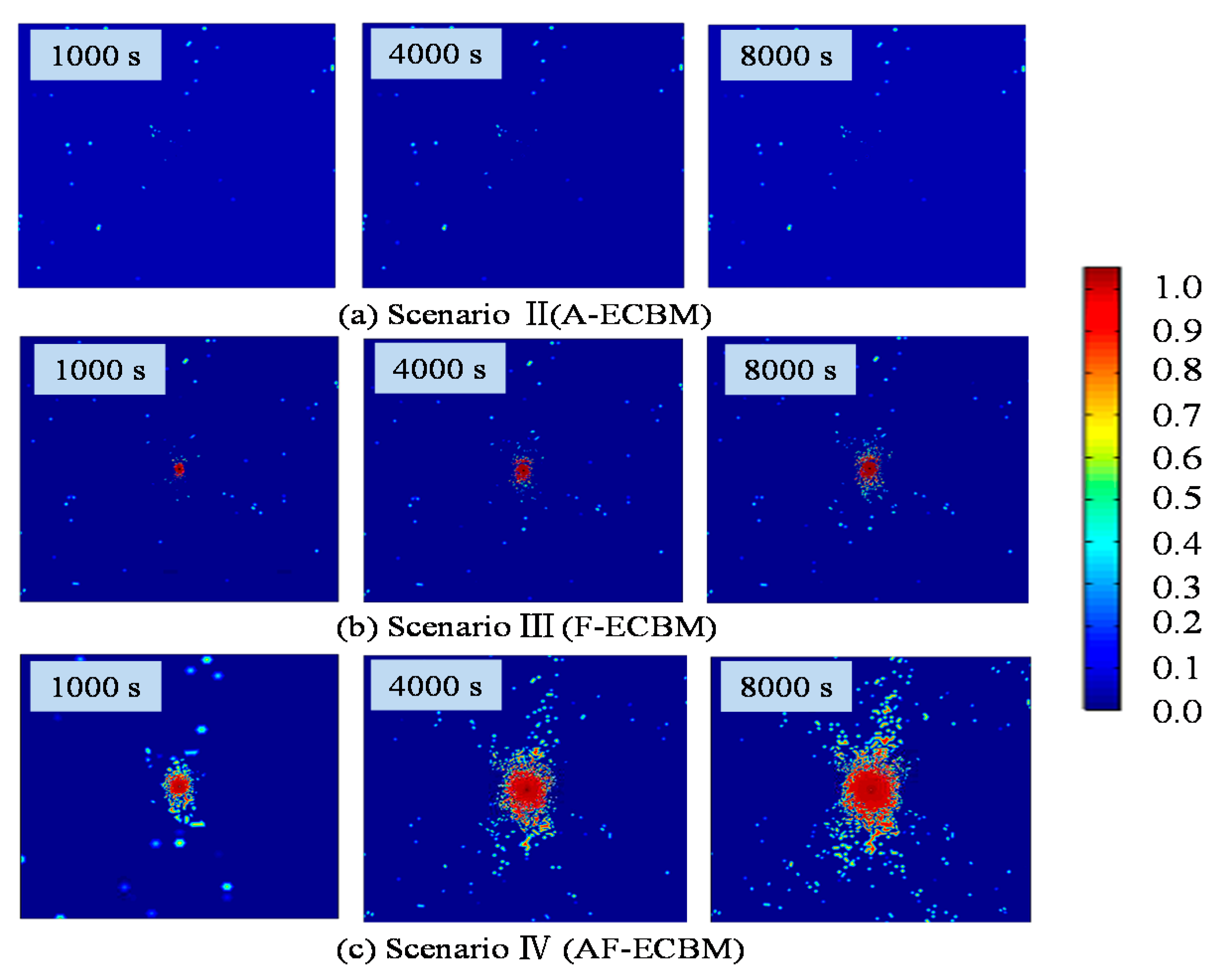

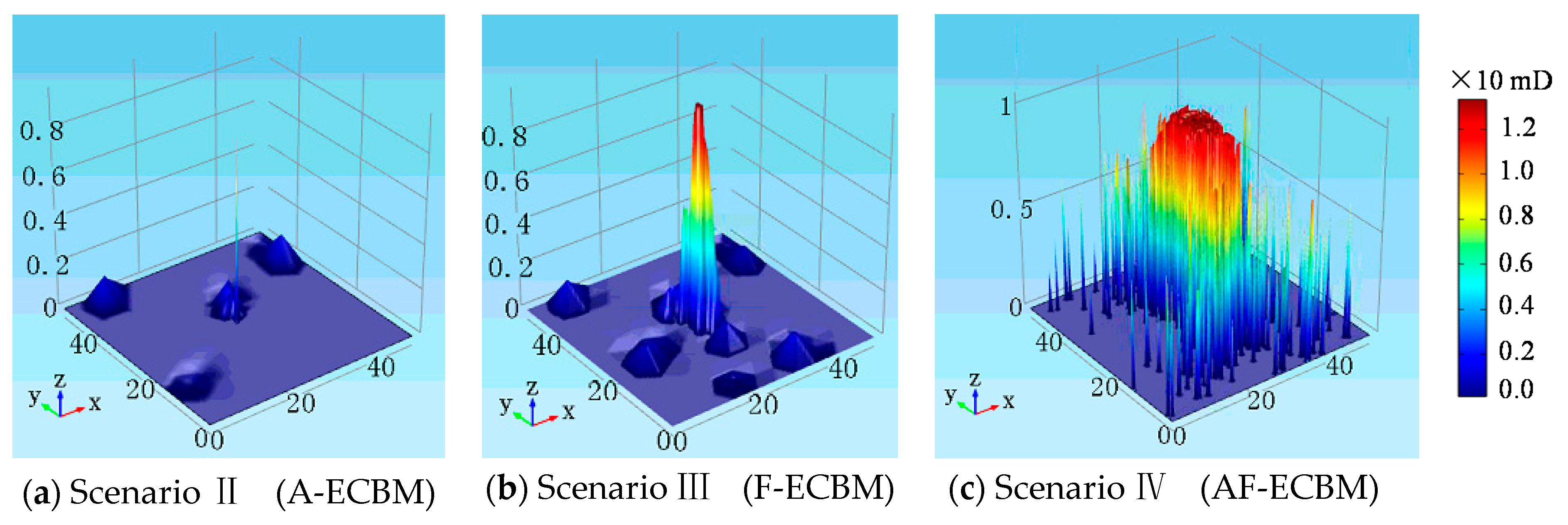
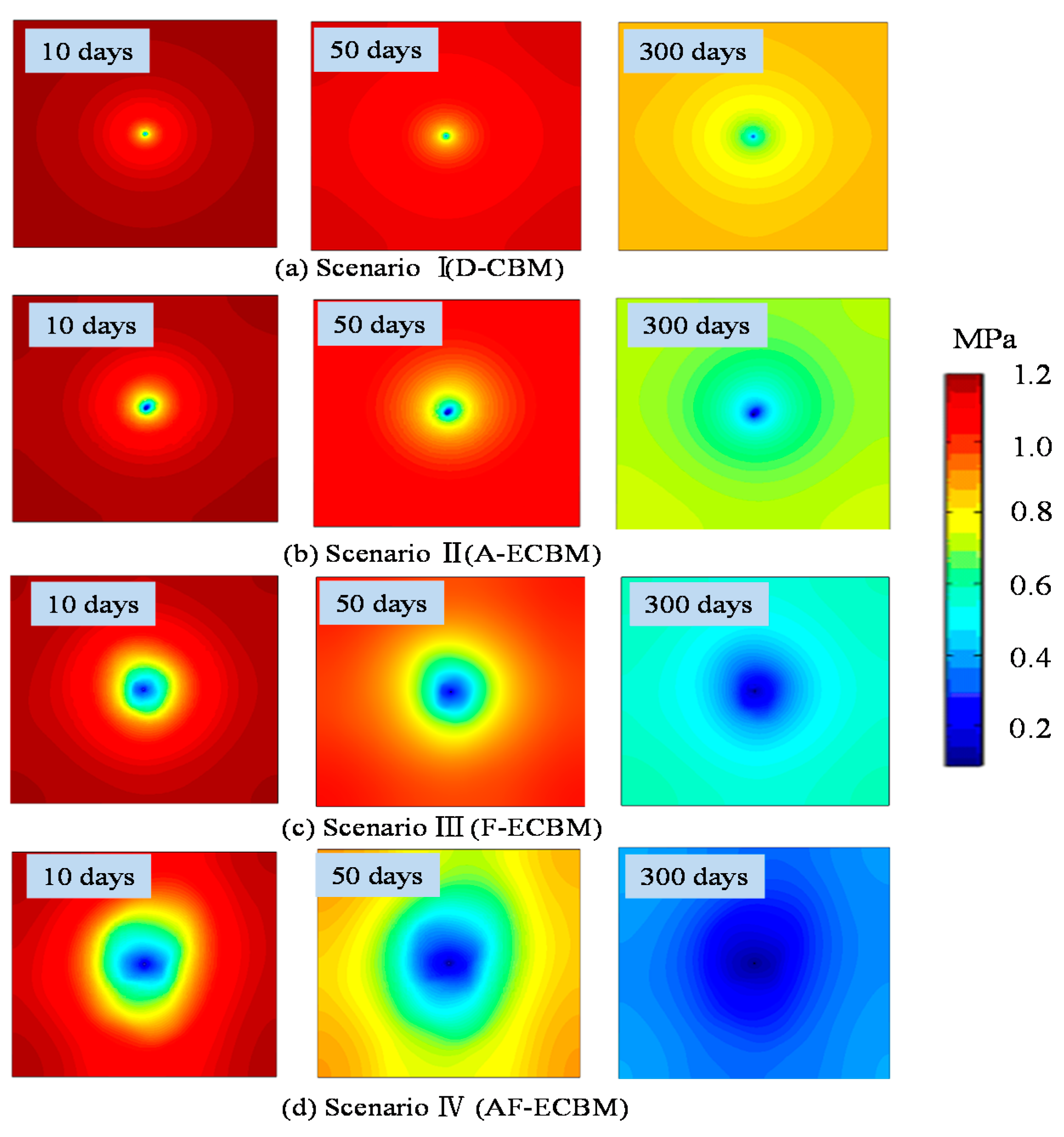
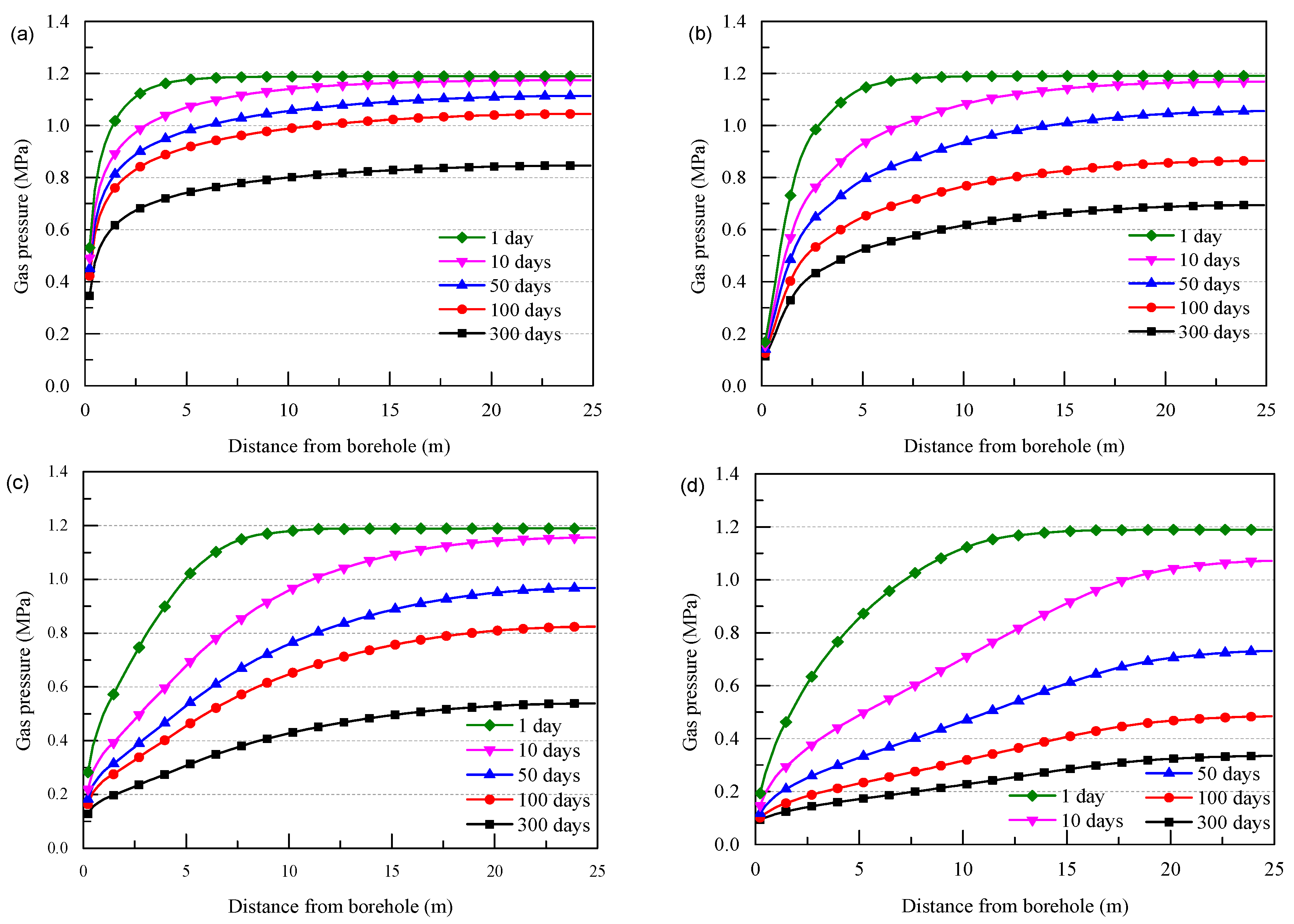
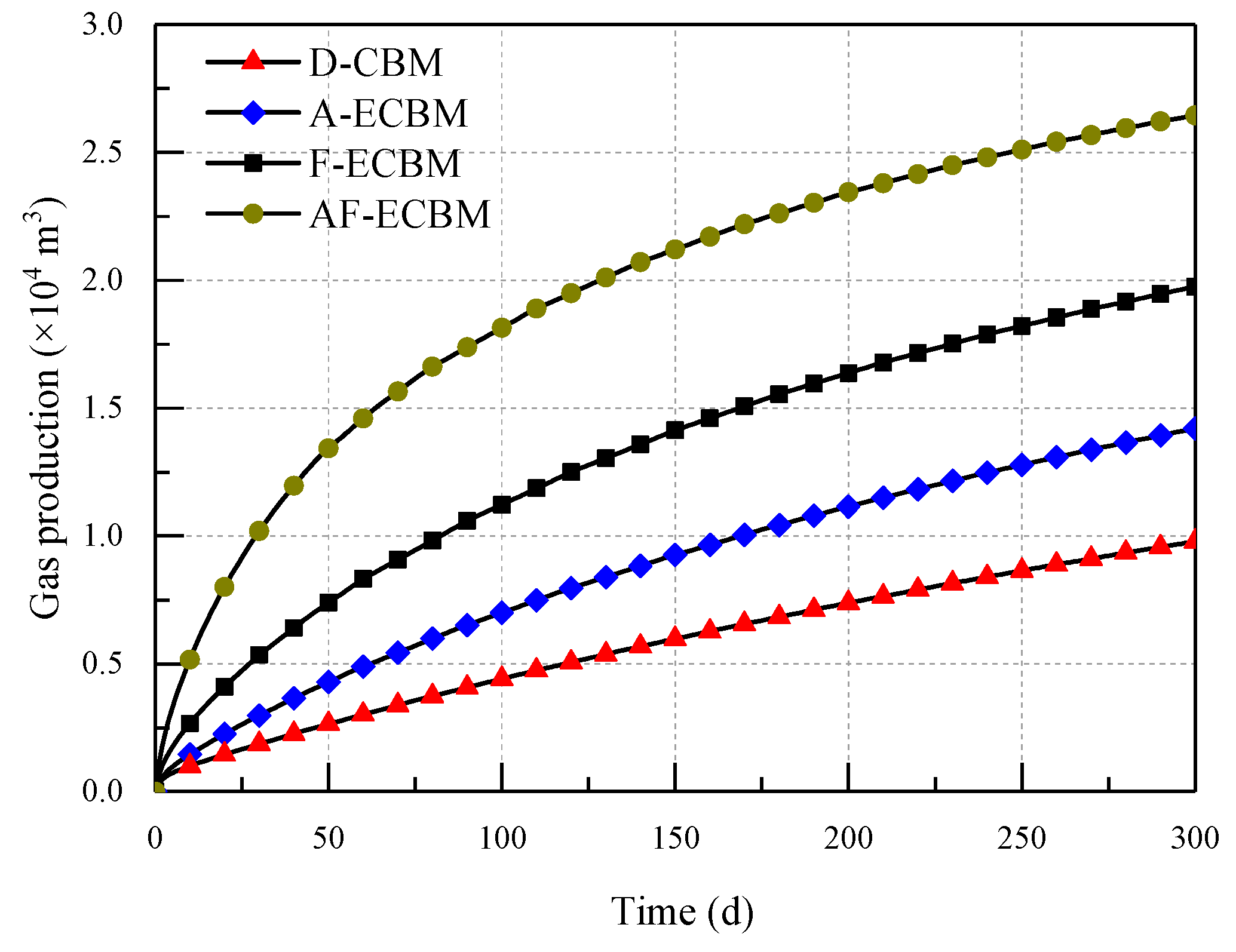
| Variable | Parameters | Value | Unit | Remark |
|---|---|---|---|---|
| τ | Adsorption time | 9.2 | d | [8] |
| σt | Tensile strength of coal | 1.38 | MPa | Experimental data |
| E | Elastic modulus of coal | 4.2 | GPa | [33] |
| Es | Elastic modulus of skeleton | 8.4 | GPa | [33] |
| Kn | Fracture stiffness | 4.8 | GPa/m | [33] |
| ν | Possion’s ratio | 0.29 | MPa | Experimental data |
| c | Cohesion of coal | 2.54 | Experimental data | |
| φ | Internal friction angle of coal | 32.2 | ° | Experimental data |
| Cs | Specific heat capacity of skeleton | 1350 | J/(kg·K) | [30] |
| Cg | Specific heat capacity of gas | 2160 | J/(kg·K) | [30] |
| Cw | Specific heat capacity of water | 4200 | J/(kg·K) | [30] |
| pcgw | Capillary pressure | 0.05 | MPa | [30] |
| μg | Dynamic viscosity of gas | 1.84 × 10−5 | Pa·s | [40] |
| μw | Dynamic viscosity of water | 1.01 × 10−3 | Pa·s | [30] |
| φm0 | Porosity of coal matrix | 0.055 | [27] | |
| φf0 | Porosity of coal fractures | 0.034 | [27] | |
| ρs | Density of skeleton | 1470 | kg/m3 | [32] |
| ρw | Density of acid liquid | 1095 | kg/m3 | [39] |
| ρg | Density of gas | 0.717 | kg/m3 | [41] |
| Tb | Experimental temperature | 300 | K | [40] |
| qst | Equivalent adsorption heat | 33.4 | kJ/mol | [30] |
| swr | Irreducible water saturation | 0.32 | [42] | |
| Eaj | Reaction activation energy | 9180 | J/mol | [43] |
| wj | Frequency factor | 5.684 | [43] | |
| A | Material coefficient | 0.3 | [43] | |
| B | Material coefficient | 2.13 | [43] | |
| λs | Thermal conductivity of skeleton | 0.191 | W/(m·K) | [27] |
| λg | Thermal conductivity of gas | 0.031 | W/(m·K) | [27] |
| λw | Thermal conductivity of water | 0.598 | W/(m·K) | [27] |
| αT | Expansion coefficient of skeleton | 2.4 × 10−5 | 1/K | [40] |
| PL | Langmuir pressure constant | 3.034 | MPa | [32] |
| VL | Langmuir volume constant | 0.036 | m3/kg | [32] |
| εL | Expansion coefficient for gas sorption | 0.032 | [33] | |
| d1 | Thermal coefficient of gas sorption | 0.071 | 1/MPa | [40] |
| d2 | Thermal coefficient of gas sorption | 0.021 | 1/K | [40] |
| sgr | Residual gas saturation | 0.15 | [8] | |
| ξ | Jump coefficient of permeability | 55 | [2] |
© 2019 by the authors. Licensee MDPI, Basel, Switzerland. This article is an open access article distributed under the terms and conditions of the Creative Commons Attribution (CC BY) license (http://creativecommons.org/licenses/by/4.0/).
Share and Cite
Fan, C.; Luo, M.; Li, S.; Zhang, H.; Yang, Z.; Liu, Z. A Thermo-Hydro-Mechanical-Chemical Coupling Model and Its Application in Acid Fracturing Enhanced Coalbed Methane Recovery Simulation. Energies 2019, 12, 626. https://doi.org/10.3390/en12040626
Fan C, Luo M, Li S, Zhang H, Yang Z, Liu Z. A Thermo-Hydro-Mechanical-Chemical Coupling Model and Its Application in Acid Fracturing Enhanced Coalbed Methane Recovery Simulation. Energies. 2019; 12(4):626. https://doi.org/10.3390/en12040626
Chicago/Turabian StyleFan, Chaojun, Mingkun Luo, Sheng Li, Haohao Zhang, Zhenhua Yang, and Zheng Liu. 2019. "A Thermo-Hydro-Mechanical-Chemical Coupling Model and Its Application in Acid Fracturing Enhanced Coalbed Methane Recovery Simulation" Energies 12, no. 4: 626. https://doi.org/10.3390/en12040626




